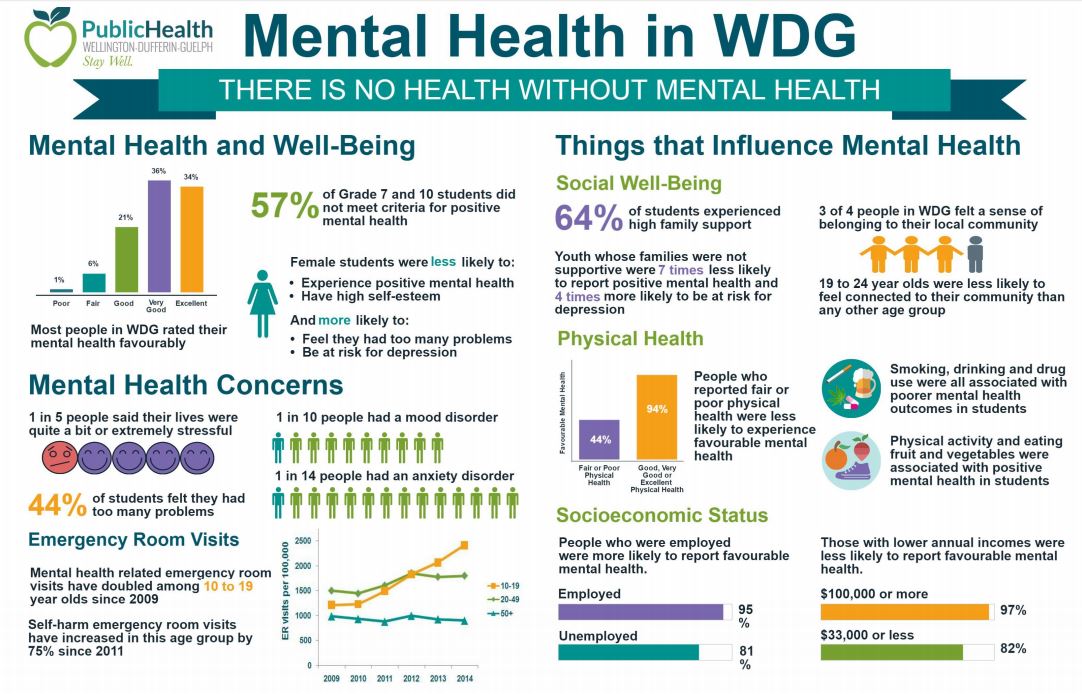In any given year, 1 in every 5 Canadians is affected by mental illness. This represents an economic burden of over 50 billion dollars each year. This report provides up-to-date and relevant information about mental health in Wellington, Dufferin and Guelph.
You can download the full Mental Health Status Report (will link to accessible PDF, xx pages, xx MB) or view the key findings below.
Mental Health and Well-Being
-
WDG residents report high levels of mental health and life satisfaction 91% said they experienced favourable mental health, 92% experienced life satisfaction
-
Among youth, younger students and males tend to experience better mental health Males and grade 7 students were more likely to experience positive mental health and have high self-esteem than females and grade 10 students
-
Social relationships are important to promoting mental health Family support and peer connections were strongly linked to positive mental health in youth
Mental Health Concerns, Mental Illness and Self-Harm
- Stress is a concern for both adults and youth 23% of people reported high life stress, 26% reported high work stress. 44% of youth said that they had too many problems. Women were more likely to report stress
- WDG and Ontario have similar rates of mood and anxiety disorders 9% of WDG and Ontario residents have a mood disorder. 7% of WDG residents and 8% of Ontarians have an anxiety disorder
- Emergency room data suggests many youth are distressed ER visits for mental health concerns among 10-19 year olds doubled from 2009 to 2014
The Relationship between Physical and Mental Health
- Mental health and physical health are strongly linked. Residents who rated their physical health as good, very good or excellent were much more likely to experience favourable mental health
- Healthy habits were associated with better mental health among youth Physical activity and eating habits were significantly associated with mental health outcomes
- There is a strong link between substance use and mental health. Smoking, heavy drinking and drug use were all strongly associated with poorer mental health outcomes
Social Determinants of Mental Health
- Employment is strongly associated with mental health. Ontarians who were employed were significantly more likely to report positive mental health than Ontario residents who were not employed
- Income level can also have a considerable impact on mental health. Lower-income residents of WDG were significantly less likely to experience favourable mental health than those with higher incomes.

Conclusions The purpose of this report is to provide both individuals and organizations in WDG with up-to-date and relevant information about mental health in the region. This report also stresses the importance of several factors that are significantly associated with mental health in the hope that it will spark discussions on how to best promote optimal mental health among all WDG residents.
- Many WDG residents experience favourable mental health. The rates of many mental health indicators for WDG were similar to those found for Ontario overall. Positive social relationships and feelings of connectedness were associated with better mental health, especially among youth.
- Mental health concerns tend to be associated with gender. Women reported more stress and higher rates of mood and anxiety disorders. They also accessed mental health services more frequently than men. However, men were more likely to commit suicide.
- Adolescence may be a time of increased vulnerability. Grade 10 students had considerably higher rates of mental health concerns than grade 7s, including risk of depression, thoughts of self-harm and thoughts of suicide. Grade 10 students were also less likely to experience positive mental health or high self-esteem. The dramatic increase in ER visits for mental health concerns and self-harm among 10-19 year olds is cause for concern. Adolescent females may be particularly at risk.
- Mental health was strongly related to physical, behavioural and social conditions. Physical health was significantly associated with mental health. Behaviors that promote or threaten physical health appear to be strongly related to mental health among youth. Social and economic circumstances also play a significant role in mental health, especially income and employment.
